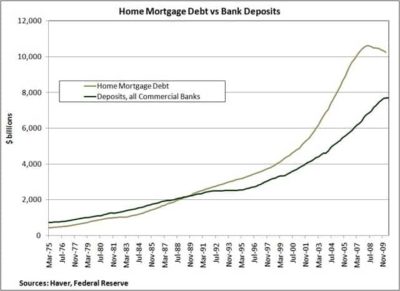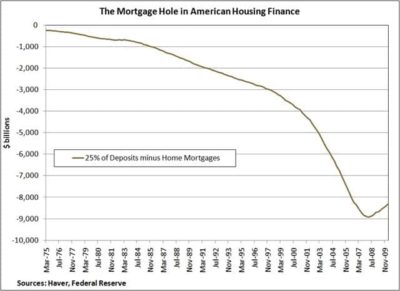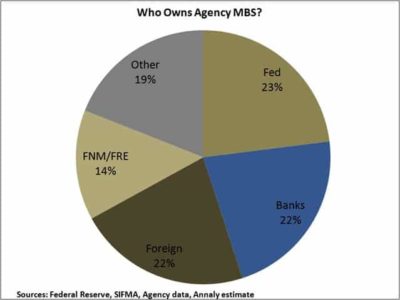Letter from a Washington Conference Room
By Michael Farrell, Annaly Capital Management
My fellow mortgage market participants,
On Tuesday, I attended the “Conference on the Future of Housing Finance” hosted by Treasury Secretary Tim Geithner and Housing and Urban Development Secretary Shaun Donovan in the Cash Room at Treasury. I believe Annaly was invited because we have been actively engaged in the process in Washington, including submitting a response to Treasury’s request for public input on housing finance reform, and because we are a sizeable representative of the constituency of mortgage investors. We’re glad to be a part of the discussion, as I feel it is incumbent on us to share our views with policymakers and legislators on this matter of great national importance. As a company we are active in the markets, and we believe that our experience and insight can help provide some context and sense of consequences for different policy options.
The purpose of this letter is not to provide a play-by-play summary of the conference, as these details have been well-described in other venues and media. Rather, with this letter I hope to provide a few of my main take-aways.
First, the scope of the panelists, the diversity of the attendees and the range of breakout sessions was sufficiently broad to make this conference a success at airing a wide range of perspectives and opinions, but it was not a venue for making any progress towards a resolution. Thus, anyone who was anticipating a momentous announcement or watching the live webcast or the TV coverage should have ratcheted down their expectations about the conference’s intentions. While the nominal intent of the day was, as Secretary Geithner put in his opening remarks, to “consider the challenge of how to build a more stable housing finance system,” the best outcome was that every constituency could come away from it feeling that their voice had been heard. At the end of the day, the conference was substantive and informative, but it did not advance the ball.
After all, it was a fairly straightforward exercise to go to www.regulations.gov to download the submissions of the panelists or visit their websites to know, more or less, what each of them was going to say. Alex Pollock was going to advocate for a transition to a market with no GSEs, just private secondary market support. Lew Ranieri’s take was that securitization isn’t the villain, bad underwriting is. Keep the wrap, but make it for a smaller segment of the market within FHA. Susan M. Wachter was on the Center for American Progress’s Mortgage Finance Working Group (even though it wasn’t mentioned in her biography that was circulated at the conference), and their proposal, in brief, is they believe in the government guarantee and support continuing Ginnie Mae in its current form and creating “Chartered MBS Issuers” (CMIs) to insure securities. A CMI could be a utility, a co-op, a mutual or other private investor model, but with sufficient capital to protect the taxpayer. Leaders of the home mortgage businesses of Bank of America and Wells Fargo both generally agreed on risk-based pricing for a government guarantee although they didn’t have a specific model in mind. They probably would agree, however, with the proposal of the Mortgage Bankers Association, which favors government support of the secondary market through a security- level government guarantee, much like a Ginnie Mae wrap, which would in turn be backed by “private, loan level guarantees from privately owned, government chartered and regulated mortgage credit-guarantor entities (MCGEs).” The MCGEs would be the issuers of the MBS. Other panelists addressed affordable housing, multi-family housing and affordable rentals.
So if I basically knew what each speaker was going to say, and if expectations were managed to an appropriate level, why did I go? Well, sometimes we learn more from attending a live event than from watching it on TV or reading transcripts. For example, the Cash Room at Treasury is a small, but ornate room with a long history associated with it. It lent a certain grandeur, gravitas and excitement to the conference, and as a result I felt the participants were engaged, maybe even a little on edge about being there. It was a very scripted event, with Secretary Geithner and then Donovan each running their panels very tightly, with little exchange between panelists and no questions or comments at all from the audience. Also, I sensed that Secretaries Geithner and Donovan were uncomfortable serving as panel moderators, and if they were I can’t blame them. Think about it: They are the people supposedly providing leadership on housing finance reform, and during this conference they were little more than facilitators. I suppose their involvement was intended to show the seriousness with which the Administration is taking this issue, but I can only speculate on the execution.
I also went to represent a particular constituency which too often is overlooked in the discussions—the secondary market investors who provide the majority of the capital to the $11 trillion mortgage market. I believe all the discussion and theorizing about housing policy reform that is done by most of the panelists is done in a virtual world, a world without costs or consequences because they do not consider my perspective. Academicians and dogmatists, think-tanks and policy wonks can come up with myriad models and theories, but there is scant attention paid to the fact that reforming housing policy is about price. It is, or should be, about what mortgage rates will be in any new model, which in turn will affect the value of the nation’s housing stock. And we in the secondary market set that price. And as Annaly said in its submission to Treasury, “The market will adapt to whatever policy objective comes out of Washington, most likely by repricing the risk, uncertainty and friction of whatever replaces the current system. The consequences of change are that the size, scope, availability and efficiency of the current housing finance system will change as well. If the new system is significantly different than the housing finance system we have now, the consequences may be that our housing finance system is smaller, perhaps more appropriately priced, but with lower housing values and less flexibility and mobility for borrowers.” We could have added that the knock-on effect of any significant change would likely be felt in industries and workers in related fields, like home construction, real estate brokerage, building materials and housing-related consumption.
Which brings me to my next take-away, which is related to Bill Gross’s comments on the first panel. Mr. Gross also represents the investor base in mortgage-backed securities, and I agree with much of what he said, with two minor exceptions. In particular, I don’t agree with his belief that a cure for what ails the economy is a blanket refinancing option for anyone who is current on a GSE securitized mortgage, regardless of credit history, documentation and loan-to-value. Treasury has already taken the unusual step of refuting the possibility. “The administration is not considering a change in policy in this area,” Treasury spokesman Andrew Williams said on August 5. Leaving aside the moral hazard involved (the lender has no responsibility under a mortgage agreement to protect the downside risk of home prices falling just as the homeowner has no obligation to share any upside with the lender), the rumored plan doesn’t hold water. First, the potential stimulus amounts—Gross’ estimate of $50 billion per year is in line with others—is not insignificant, but it is not a game changer and it is not without cost. Look how effective the stimulus plan has been. Not least is the extent to which we get a population that is entrenched in their low mortgage rate homes in the event they had to move in the middle of a higher interest rate environment. But more to the point of how we got here, if there are no underwriting standards as part of a refi/stimulus plan under the GSE umbrella, the government would essentially be guaranteeing un-diligenced borrowers with un-valued collateral. The actual process of refinancing itself would constitute a large capital call on banks needing to refinance the mortgages. Furthermore, to the extent that Fannie Mae and Freddie Mac are taking steps to recoup money for taxpayers—through putting back mortgages that were improperly underwritten or suing issuers of fraudulent private label securities—a refinancing program like this would undermine that effort. This idea is nothing more than an interesting hypothetical thought exercise. In any event, refinancing activity is picking up of its own accord through conventional channels and with appropriate underwriting standards as mortgage rates continue to drop.
Another point Gross made is that “PIMCO would not buy a private or a privately insured mortgage pool unless it was accompanied by a 30 percent down payment…” As we said in our submission, the market will adapt to whatever policy decision comes out of Washington by repricing. PIMCO may decide it needs to reprice by demanding a 30 percent down payment, but that is unrealistic in today’s market. We think the market would likely reprice through a combination of stronger underwriting standards and higher, potentially much higher, rates.
Despite these quibbles, I am in total agreement with the main thrust of his statement: “To suggest that there’s a large place for private financing in the future of American housing finance is unrealistic….To suggest that the private market can come back in and take the place [of the government balance sheet] and do the same thing that they’ve done for the past 20 or 30 years is simply impractical. It won’t work.”
To prove the point, consider the following graph. It shows the trends in home mortgage debt and bank deposits in the United States over the past 35 years. What becomes clear is that with almost $11 trillion in home mortgage debt and less than $8 trillion in deposits, the banking system alone is not sufficient to fund all home mortgages in the United States.
The size of the shortfall between home mortgage debt and deposits is illustrated in the following graph. In it, we have to start with an assumption that not all deposits would be used to fund mortgages. Instead, we use the recent historical evidence that the average mortgage-to-deposit ratio among FDIC-insured banks is about 25%. In this case, the hole is about $8 trillion.
This hole between the demand for housing credit and the supply of capital is mostly filled by the securitization market. Taken together, in round numbers, that $8 trillion represents a good approximation for the amount of Agency and non-Agency mortgage-backed securities outstanding. About 70% of that is held by investors in rate-sensitive Agency MBS, with the balance in credit-sensitive non-Agency MBS. To paraphrase Gross, it is unrealistic to think that the buyers of credit-sensitive non-Agency MBS will show up in sufficient numbers to supplant the installed base of rates buyers. I would add, at least not at the current price. Without the support of mortgage values and home prices that is provided by the government guarantee, that hole will get smaller not by increasing demand from the traditional non-Agency buyer but by shrinking the value of the collateral and the mortgages needed to finance them.
My final take is that the general consensus among all participants in the room about how to restructure the housing finance system is a desire to 1) maintain the government guarantee in the mortgage market, 2) continue to enable the to-be-announced (TBA) mortgage market, and 3) find a replacement for the hybrid business model of Fannie Mae and Freddie Mac that can deliver these items in a manner that offers the greatest protection to taxpayers. In short, keep what works and get rid of what doesn’t. Treasury has indicated that it is working to have a plan for release by January 2011, and it has not indicated whether it currently has a plan in hand. But if we take Secretary Geithner’s on-the-record remarks at face value, I have to conclude that he agrees with this general consensus and that Treasury’s plan will reflect this.
After sitting in the Cash Room, my recommendation to Secretary Geithner is to lay out the plan as soon as possible. The cacophony of voices, proposals, hearings, conferences and headlines will not shed any more light or break any new ideas on the subject, and the delay only adds to the uncertainty that is already in the market. The fact remains that if we did not have Fannie Mae and Freddie Mac right now, the government would be trying to create something like them in order to have housing finance operate in the national interest, much like when the Roosevelt Administration created Fannie Mae in the depths of the Great Depression. And one look at the holders of Agency MBS shows me that this market is virtually on the Federal balance sheet already, so don’t shrink from it. Banks, the Fed and Fannie and Freddie themselves are already government-backed, and foreign investors have only shown interest in the asset class because of that government backing. Since 2007, the Fed has diluted the foreign holders.
I believe that Fannie and Freddie should continue to operate in conservatorship with a goal of winding down their retained portfolios over a set period of time. At that point in time they would be nationalized and perhaps merged into one entity. This would enable them to continue to have their MBS guaranteed with a government wrap, enforce underwriting standards, and enable the flow of credit from the secondary mortgage market to the primary mortgage market for conforming borrowers through the TBA mechanism.
The one aspect of Fannie and Freddie’s current business model that would have to be replaced would be their portfolio activities. That is, their mandate to provide support and stability in times of market crisis or illiquidity. The private market could step up to play that role in tandem with the Federal Reserve. Funding is an integral part of the mortgage market. The majority of Agency MBS investors in the above pie chart are leveraged. Banks, insurance companies, foreign financial institutions and many private investors use varying degrees of leverage, while the GSEs themselves and the Federal Reserve are infinitely levered. These investors fund themselves in different ways, but they are all financed by different segments of the credit market. Whether it is deposits, the repo markets, the debt markets, the Agency debt market or Treasury sales, all of these investors are levered and this financing is available and priced where it is because of the government guarantee. Rather than establish a procedure by which some instrumentality or agency of the US government sets itself up as a potential investor in mortgage assets in times of market crisis or illiquidity (like Fannie or Freddie used to, or the Federal Reserve did with its $1.25 trillion buying program), I suggest setting up a funding mechanism that would enable the private market to step into that role. In other words, the government would not be an investor of last resort, rather it would play its more traditional role as a lender of last resort. This could take the form of a TALF‐like program which comes into existence during proscribed market conditions, charges high enough margin and rates yet still enables private capital to earn a return.
There is a lot of emotion surrounding Fannie Mae and Freddie Mac. When people ask, “Where is the outrage?” regarding the mortgage debt bubble, more often than not it is the GSEs that are effigied. My suggestion to any legislator or Treasury official who is met with outraged voters at this plan is to ask a series of questions: How many of you have 30-year fixed-rate mortgages? How many of you were able to get a 60-day or 90-day rate lock when you went through your mortgage process? How many of you cashed-out home equity to pay down credit card bills, pay for college or finance a small business? Do you appreciate that you could get a mortgage from a local bank or mortgage lender as opposed to one of a small number of Wall Street money-center banks? Who here would choose to pay a higher rate in exchange for no government involvement? How much higher? 2%? 3%? 4%? How many of you understand that a likely consequence of these higher rates is that your house will be worth less?
In conclusion, please note that I addressed my letter to “fellow mortgage market participants.” This is an extremely wide swath of America; it includes stock and bond investors, lenders and borrowers, home-owners and home renters, pensioners, realtors and builders, lawyers, accountants and retailers. It underscores the primacy of this discussion to the American way of life. Housing finance reform is no less important or socialized with entitlement to the average American than healthcare or Social Security. You don’t have to own an Agency mortgage-backed security to be affected by it. As Martin Luther King put it in his letter to his fellow clergymen 47 years ago, “Whatever affects one directly, affects all indirectly.”
Yours,
Michael A.J. Farrell
Chairman, CEO and President



Comments are closed.